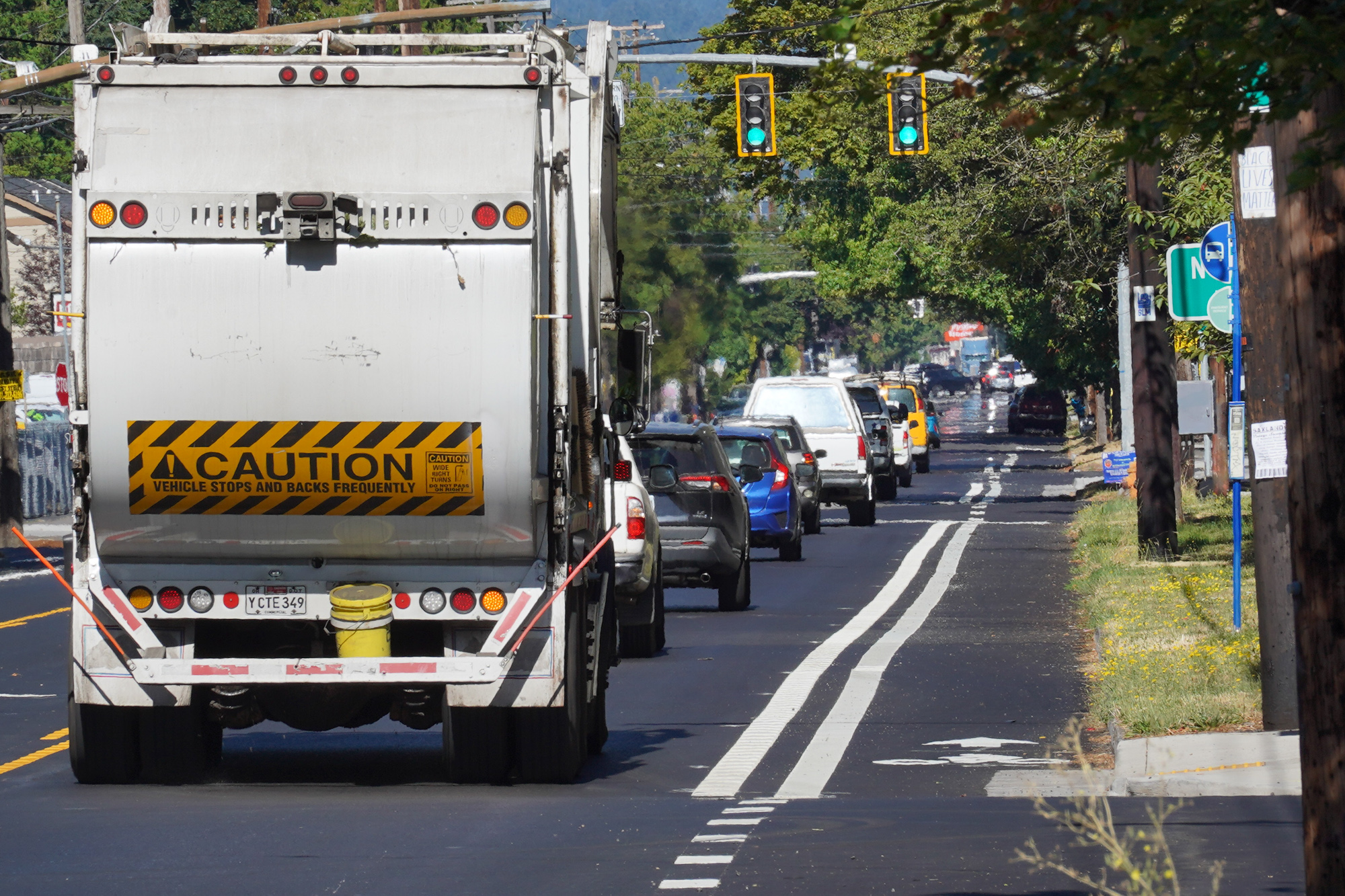

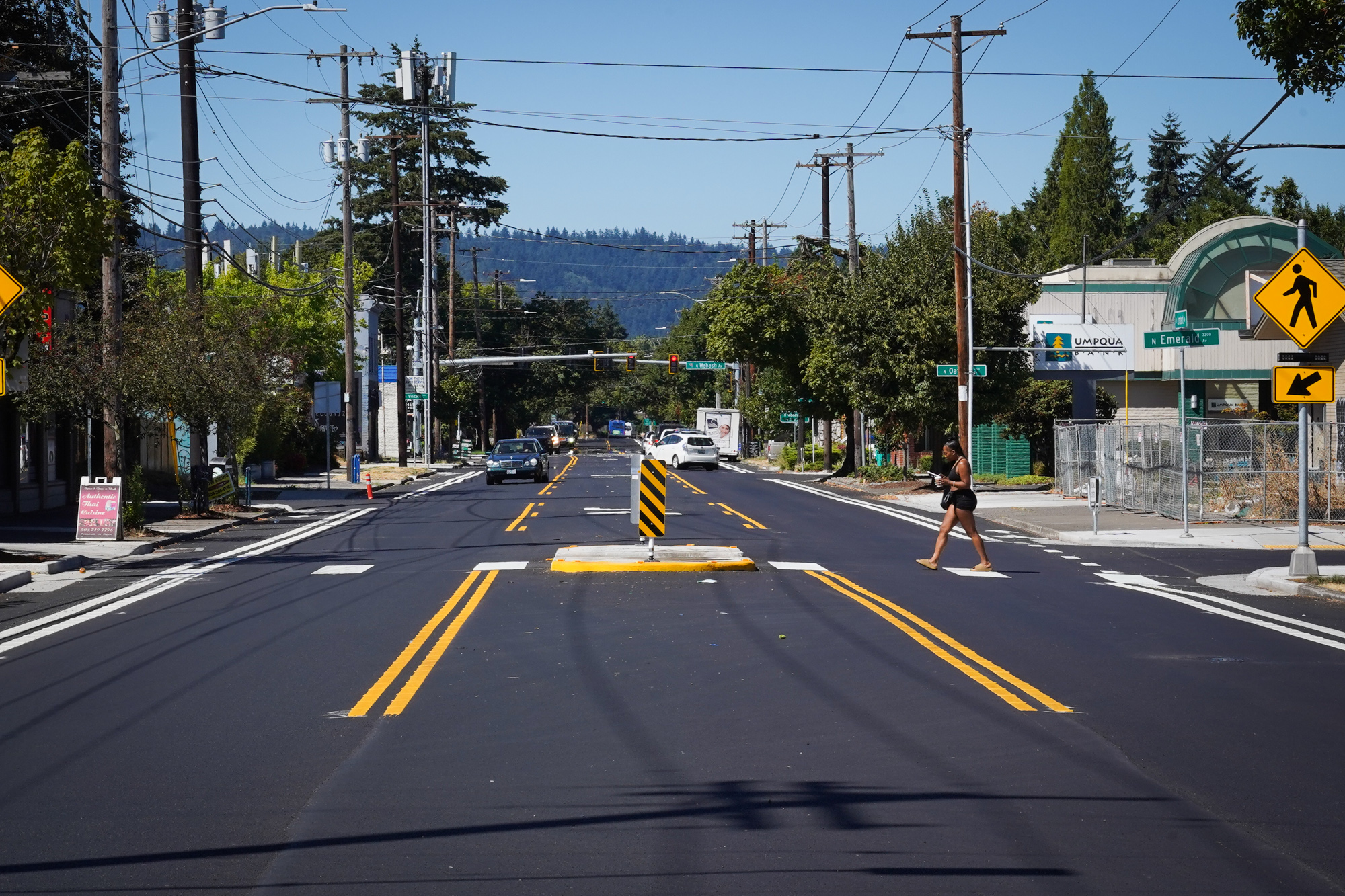
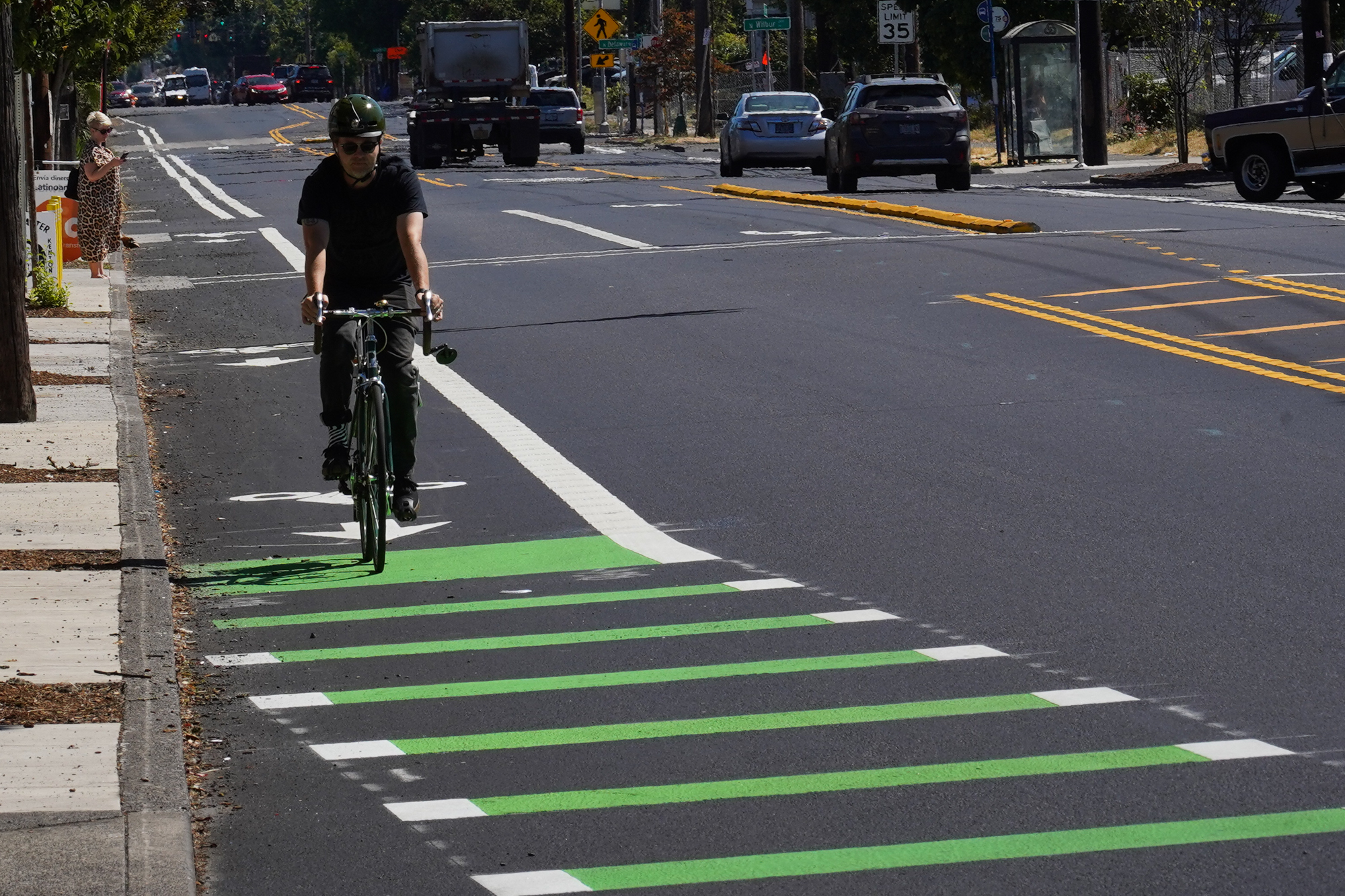
The Oregon Department of Transportation (ODOT) has completed a $16.5 million project on N Lombard Avenue that reduced space for driving and added a buffered, unprotected bike lane.
The Lombard Multimodal Safety Project stretches about 1.2 miles from N Fiske (west of Columbia Park) to N Delaware. In addition to new bike lanes the project repaved the street, upgraded ADA ramps, added new signals, added crossings with flashing beacons and medians, and more. ODOT found space for the bikeway by putting Lombard on a road diet in some sections. Instead of the previous cross-section of four general purpose lanes and a wide shoulder and/or parking lane, the new cross-section has two general purpose lanes, two bike lanes, and a center turn lane.
Since Lombard is also a U.S. Hwy 30 bypass and freight route, ODOT widened the general purpose lanes to 12 feet. The new bike lane is seven-feet wide (including the one-foot buffer). The speed limit is posted at 25 mph.
This project is the third time in recent years ODOT has added bike lanes to Lombard. In 2015 they striped from N Ida across the railroad cut to N Wall (leaving a glaring gap across the railroad overpass). Then in 2017 they striped a bike lane from Wall to Portsmouth. These are all nice steps forward, but the quality of the bike lane and several key gaps leave us with a head-scratching, relatively low-quality cycling experience that isn’t likely to change travel behaviors among most people.
These newest lanes are almost a dozen blocks east of where the bike lane ends on Portsmouth. And it’s another 10 blocks or so east of where they end at Delaware to the existing bike route on N Denver Ave. The gaps are a bummer, but when you consider that these bike lanes just unceremoniously end and plop (perhap unsuspecting) bike riders into a stressful, shared-lane environment is a real safety concern.
As for the bike lanes themselves, they are a welcome step in the right direction. To have dedicated cycling space on a major street like Lombard through a section loaded with important destinations like churches and parks and businesses is a very big deal. I rode them back and forth several times on Tuesday morning and — while I prefer physical protection — I felt like I was finally welcome.
It’s very unfortunate the bike lanes have no physical separation except for very tiny bumps every few feet. For some reason ODOT is reluctant to physically protect their bike lanes. When PBOT added concrete curbs and candlestick wands to N Rosa Parks Way in 2019, ODOT demanded their section over I-5 remain unprotected and they even narrowed the bike lane. (I’ve asked ODOT why they don’t protect bike lanes and will update this story when I hear back.)
The smooth new pavement was nice (although they’ve left a lot of sewer access covers full of loose gravel!) and driving speeds already seemed slower than usual. If there’s any truism to road design, it’s that less space for driving equal lower speeds. The fact that folks no longer have a way to zoom around slower drivers is huge.
It’s just too bad that ODOT holds their bike lanes back from reaching full potential. I’ve mentioned the remaining gaps and the lack of separation, but just as problematic is the amount of debris that collects in the lanes. Curbside bike lanes on high-volume arterials always have a lot of trash, car shrapnel, gravel, leaves, and so on piled in them. We must have ironclad plans for regular maintenance on the bike lanes or people won’t use them.
I saw just as many people riding on the sidewalks instead of the bike lanes while I was out there. And the presence of debris is a big reason why. One person I spoke to put it this way: “The new bike lanes may seem like a great idea, but there’s just glass everywhere, right where you would be riding your bike.” This person said they’ve gotten 4-5 flats riding in the shoulder and that expense and hassle has led him to being a sidewalk-cyclists from now on.
There are two other notable elements of this project: The new crossing treatment at Delaware and the mixing zones at Peninsular.
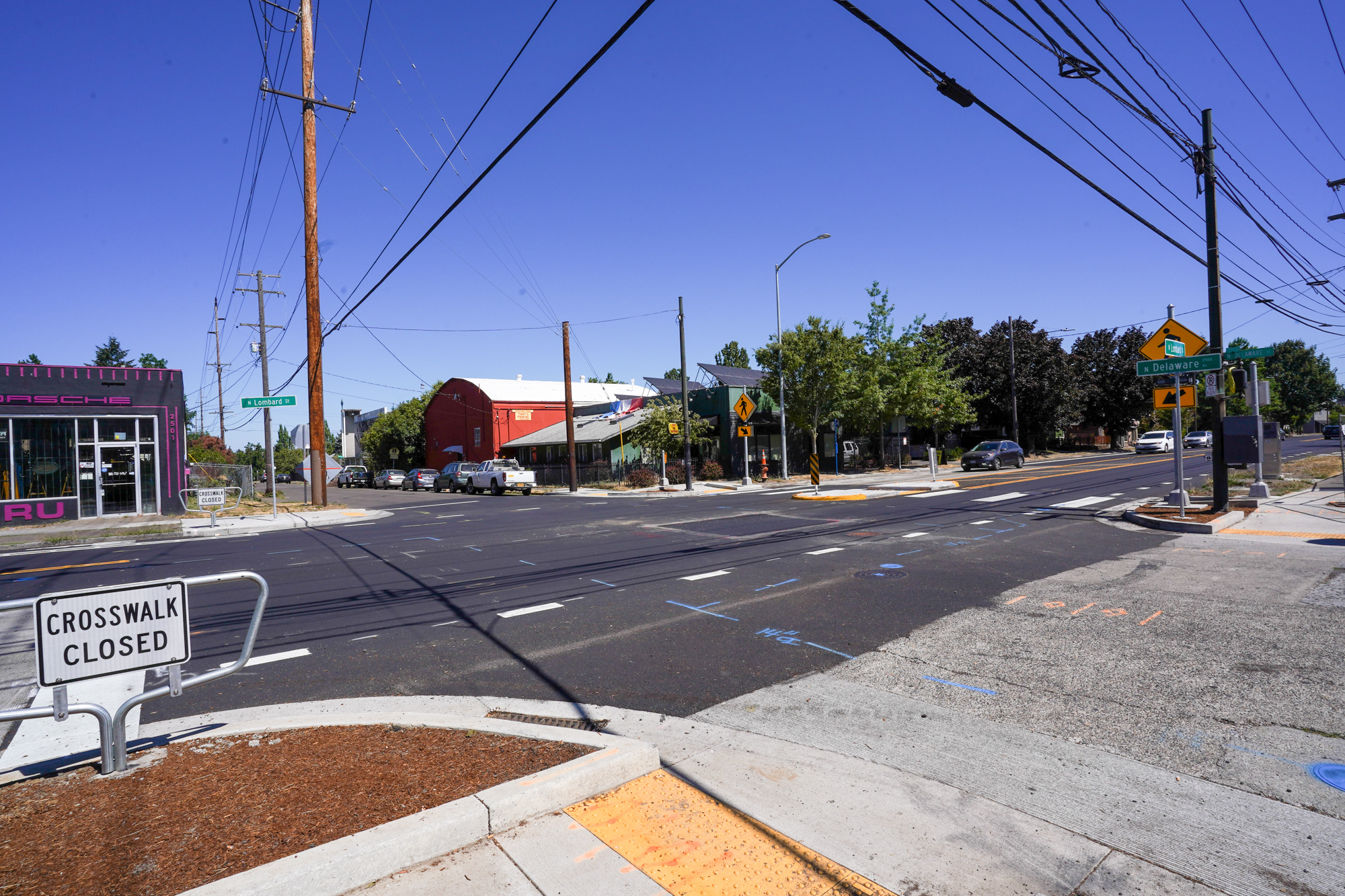

I’ve gotten three emails from concerned people (all of them moms who ride with kids) about how ODOT has changed the crossing at Delaware. This is a very important north-south bike route with two schools (Portland Village and Chief Joseph Elementary) just a few blocks away. Previously there was a half-signal (for Lombard traffic) and a marked crosswalk on the east side of the intersection. There was a beg button to activate the signal for bike riders in both directions.
Now the half-signal has been removed and in its place is a median island crossing with a rapid flashing beacon. This is nice, but it makes the intersection worse for biking in some ways. For northbound bike traffic, the beg button is now further away and requires folks to re-position up a curb ramp and into a narrow sidewalk space to use the crossing. But the changes southbound are worse.
Reader Emily W wrote in to say:
“What I find problematic is the beg button has been disengaged. To cross going south you have to [cross over both lanes] get on the (east) sidewalk, find the pedestrian button and cross in the crosswalk. It is also really annoying and potentially unsafe as people turn onto Delaware headed north and bikes are crossing over headed south to get to a signal.”
And Kristin S. wrote:
“The pedestrian activated beacon at Delaware is a huge pain for cyclists, especially for longtail and box cargo bikes. It’s on the wrong side of the road if you’re headed southbound and have to dismount because of the way the ramp is cut, and cars don’t respect the beacon like they do a stoplight. Definite downgrade from what was there before.”
I’ve asked ODOT to clarify this location and will share an update when I hear back (see updates below!).


The other notable section is the busy few blocks between N Villard/Peninsular and N Greeley (the Walgreens/Green Zebra area). The bike lane loses its buffer here as you go west approaching Peninsular and then turns into a mixing zone where you get a shared-lane environment with other road users. Westbound, the bike lane merges in a similar way. Just like the City of Portland does, there’s green color to signify a potential conflict-zone. This treatment is done to avoid the risk of right-hook collisions when curbside bike lanes come to intersections with a lot of right-turning drivers.
I felt OK in these sections, but my experience is not typical of everyone.
Overall, I’m happy to see bike lanes on Lombard, but ODOT needs to do more to make them fully functional to more people by filling more gaps, keeping the lanes free of debris, and adding protection.
What do you think? Will you ride on Lombard now?
Check the full gallery below (you can now click or swipe (on mobile) through our galleries if you hadn’t noticed yet):

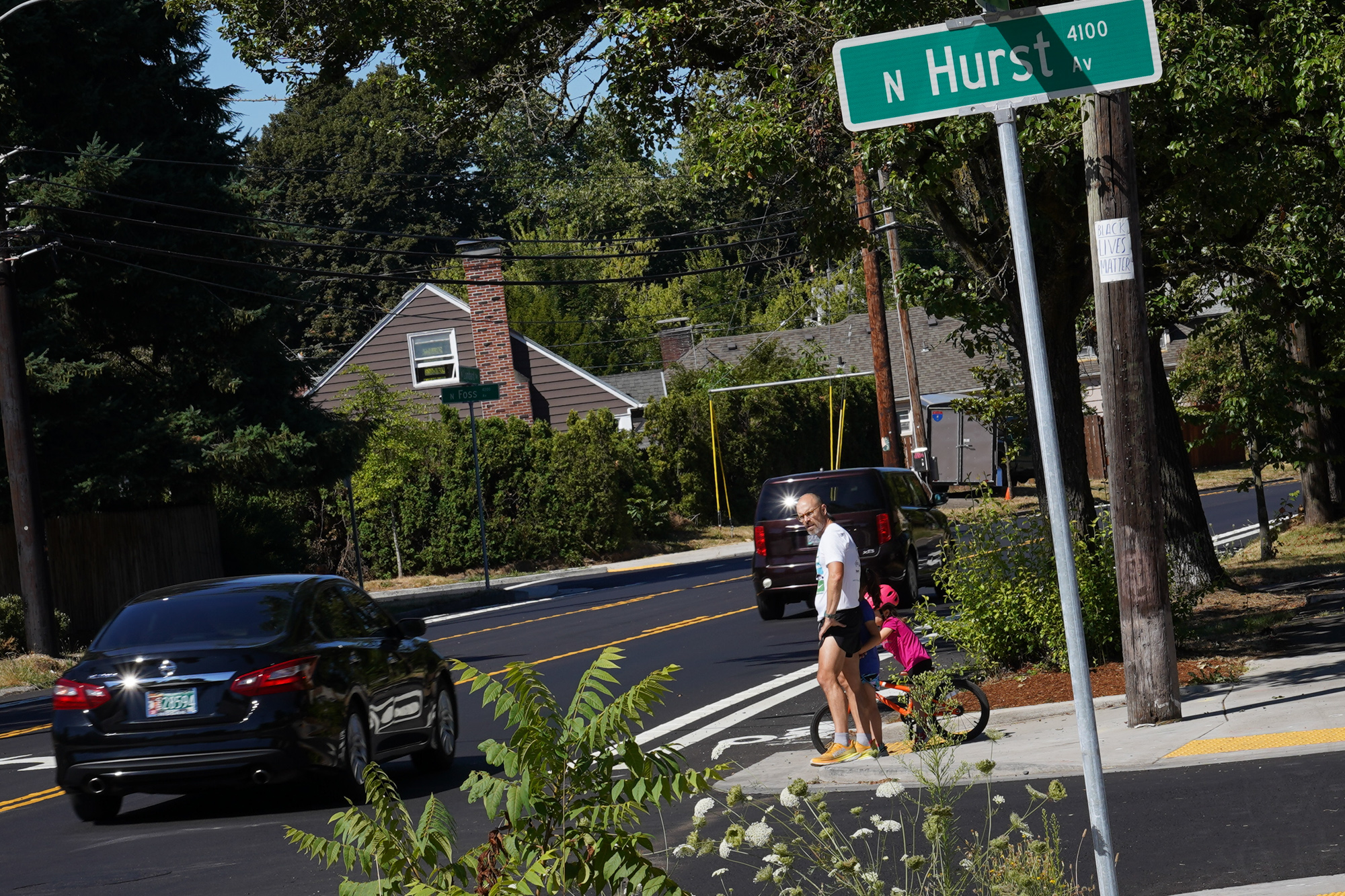


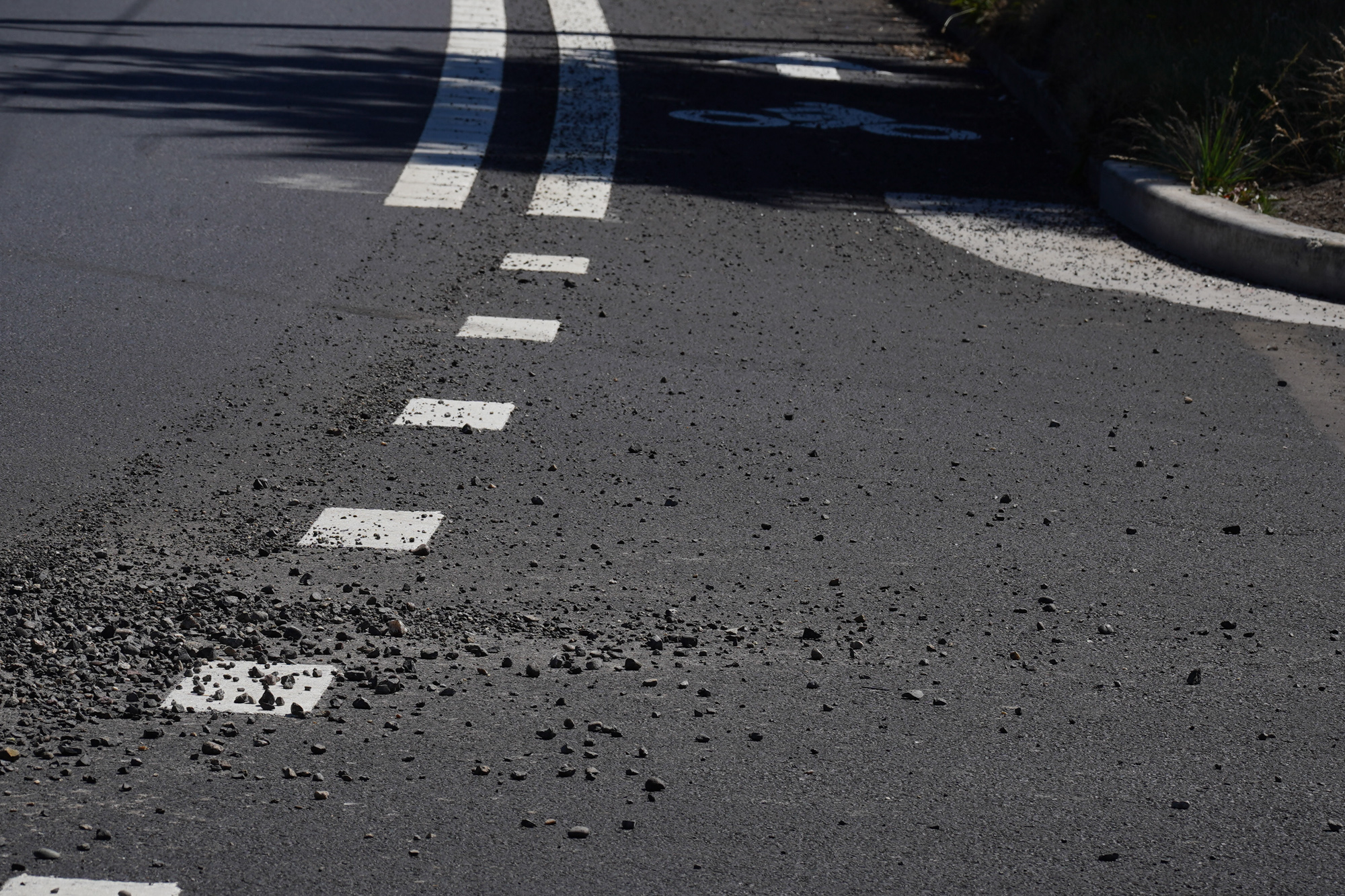



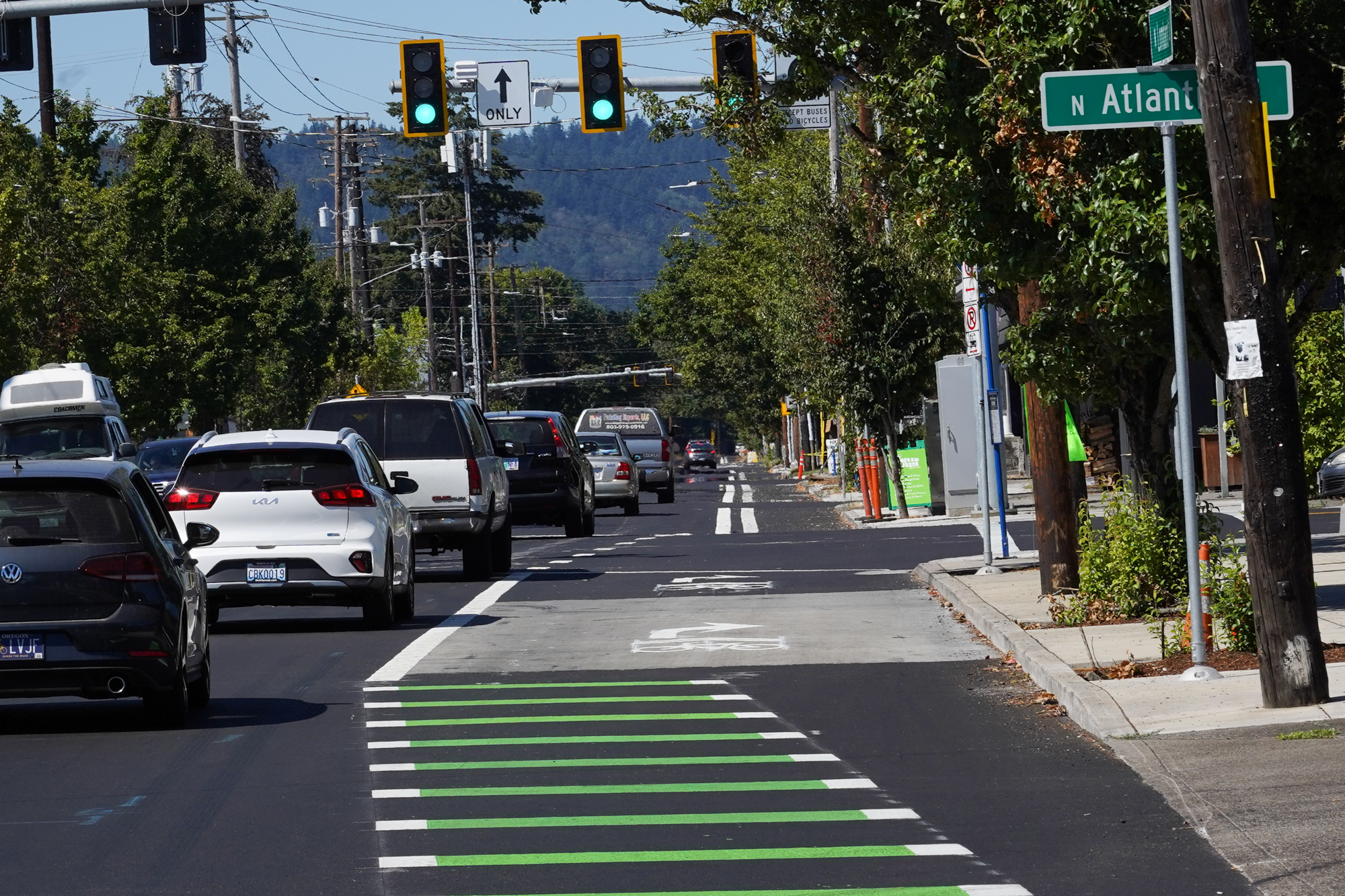



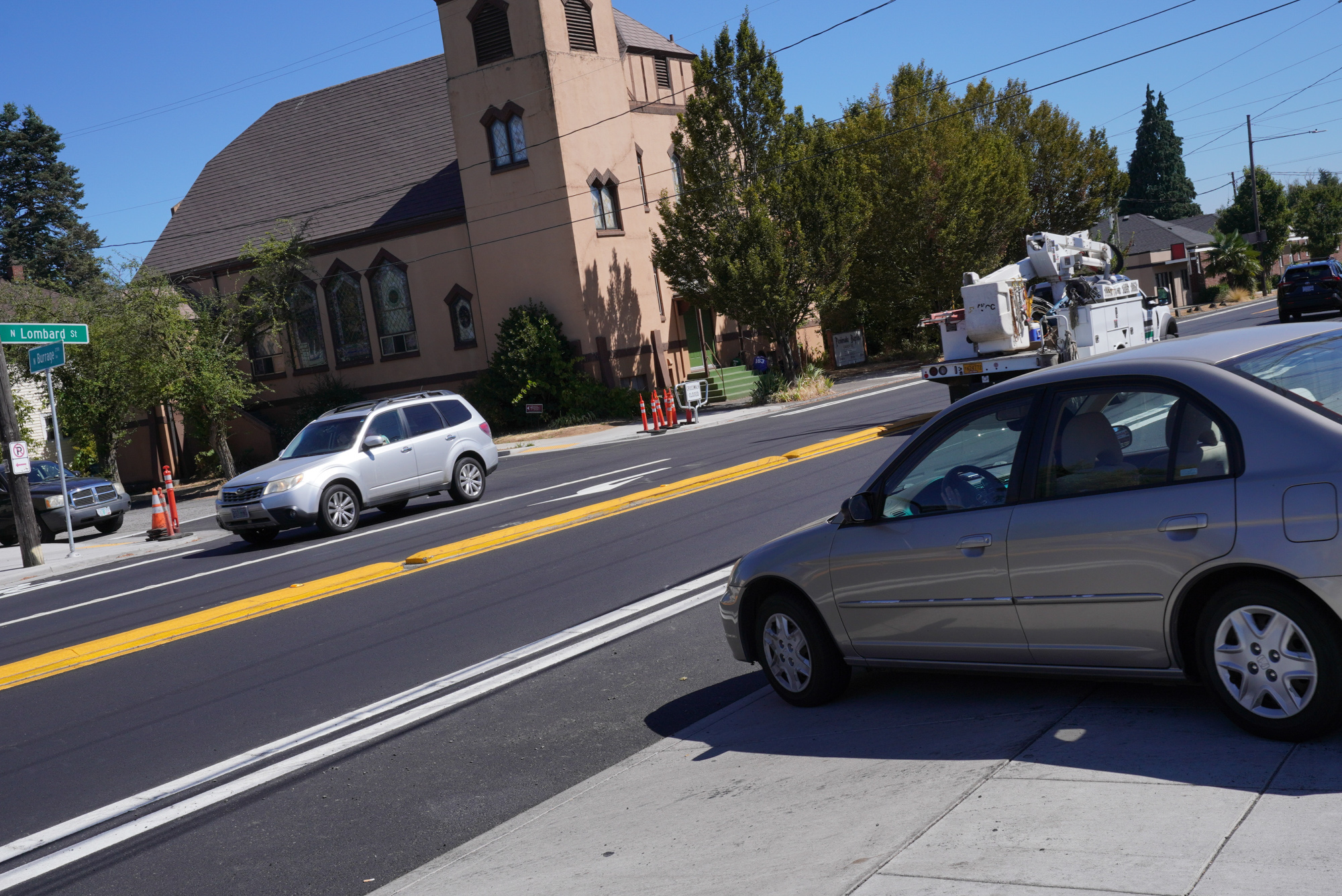

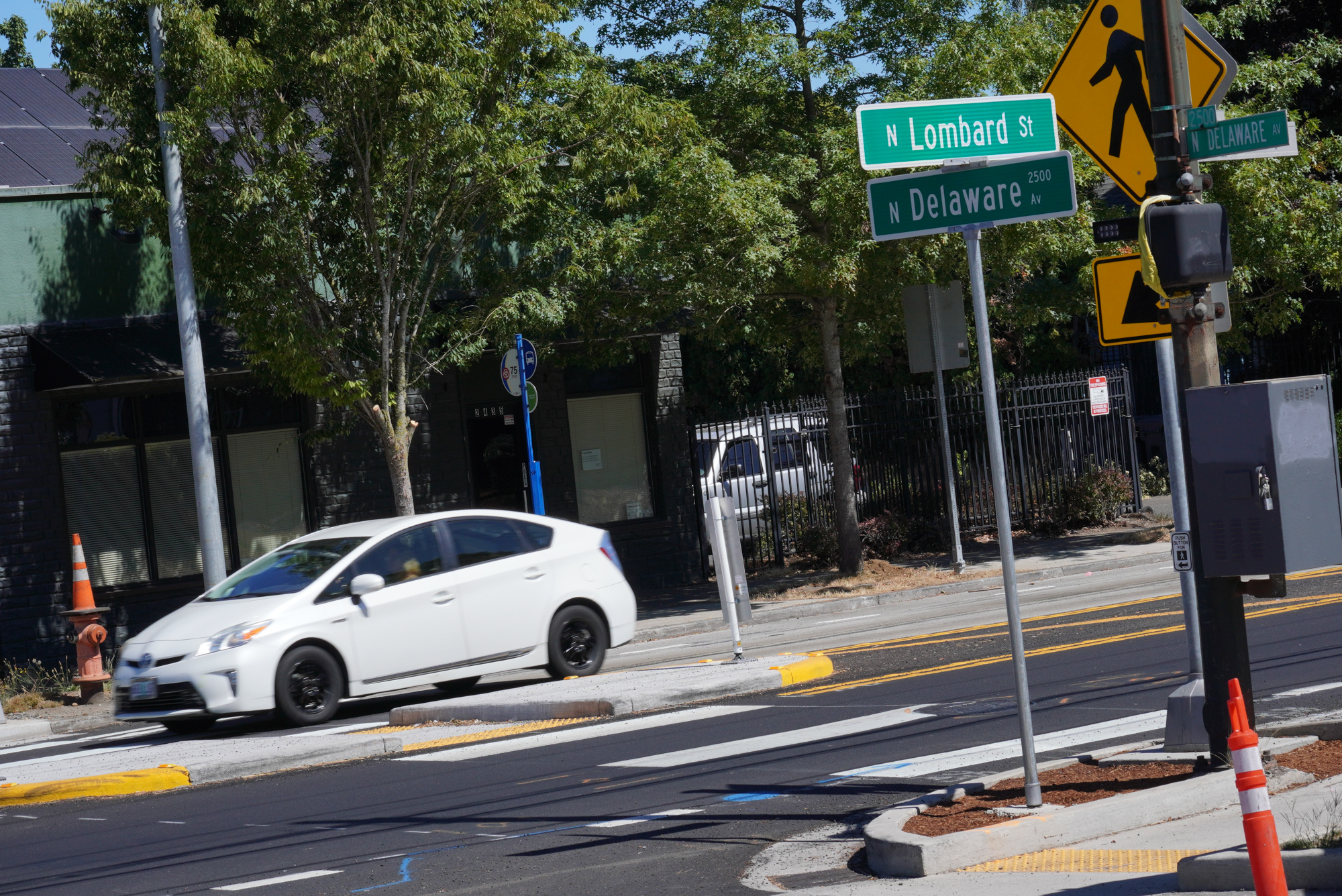
UPDATE, 2:30 pm: I’ve heard back from ODOT about the lack of physical protection and the Delaware crossing changes.
Here’s what Region 1 Public Information Officer Don Hamilton relayed about the bike lane design:
BikePortland: Why does ODOT not place plastic curbs or candlesticks in the buffer zone like PBOT often does, in order to make these bike lanes protected?
“The cross section of Lombard is limited and to install a plastic curb or candlesticks require more buffer space than what was available to ensure the devices installed can be maintained along with required shy distance to the vehicle/bicycle lanes. Lombard is also a freight route that requires a set amount of horizontal space to be provided for when larger loads have to use this road and installing curb/candlesticks would physically restrict that access.”
BikePortland: Can you clarify what bike riders are supposed to do to cross Delaware?
Southbound or northbound bike riders would need to either treat the Delaware approach like a vehicle or a pedestrian. They can use the stop control like a vehicle which will be easier to gauge now that the highway has been changed to a 3-lane cross section to judge a gap or they can go to the marked crosswalk activating the RRFB system like a pedestrian to proceed across the marked crosswalk.
Why was the traffic control method changed at Delaware?
— The age of the signal equipment means that it might simply not have enough slack in the wires or space in the conduits to move or add wires.
— The signal equipment is attached to utility poles, which does not have engineering specifications. We simply have no way of knowing if adjusting the signal heads would have a detrimental impact to the structural capacity.
— The signal heads are smaller than modern signal heads and they really should be replaced with larger ones to both meet federal standards and be more visible to drivers. However larger signal heads are heavier and would have the same issue of structural capacity as noted above.
— “Half-signals” are no longer permitted by federal standards and are expected to be removed whenever possible.
— Half-signals are noted to increase confusion and crash risk as drivers on the side street have different expectations to drivers on the mainline. In addition, since they rarely turn red, most drivers get used to the light being green and are more likely to run the red light, further increasing crash risk.
— To have a traffic signal at these locations would mean building a brand-new full traffic signal. In addition to funding difficulties from the project, these locations do not have enough traffic volumes to meet signal warrants as laid out in the MUTCD. At a rough estimate, the traffic volumes would have to be 3-4 times higher on the side streets during the peak hours to even come close to meeting the volume-based signal warrants.
— MUTCD link (https://mutcd.fhwa.dot.gov/pdfs/2009/mutcd2009edition.pdf ). Signal Warrants start on page 436.
— Though the existing signals can’t be modified to fit the project and new signals aren’t appropriate or cost-effective, we still wanted to provide an enhanced crosswalk for pedestrians. The main features of the project (reducing the number of through lanes and providing a median) make it easier for pedestrians to cross even without further enhancements. Pedestrians will have fewer conflict points to negotiate and they will have a place to wait so they don’t have to make the crossing in a single movement. Providing an island, a high visibility marked crosswalk, lighting, and an actuated beacon further enhance the visibility of pedestrians crossing at these locations.
— RRFB’s have been shown to be highly effective at getting drivers to stop for pedestrians. The rapid flash is attention grabbing unlike a traffic signal which rarely turns red and therefore is often ignored. In attention, it requires pedestrians to look that vehicles have stopped before crossing. Signals sometimes give a false sense of protection and pedestrians may cross before ensuring that it is safe to do so.



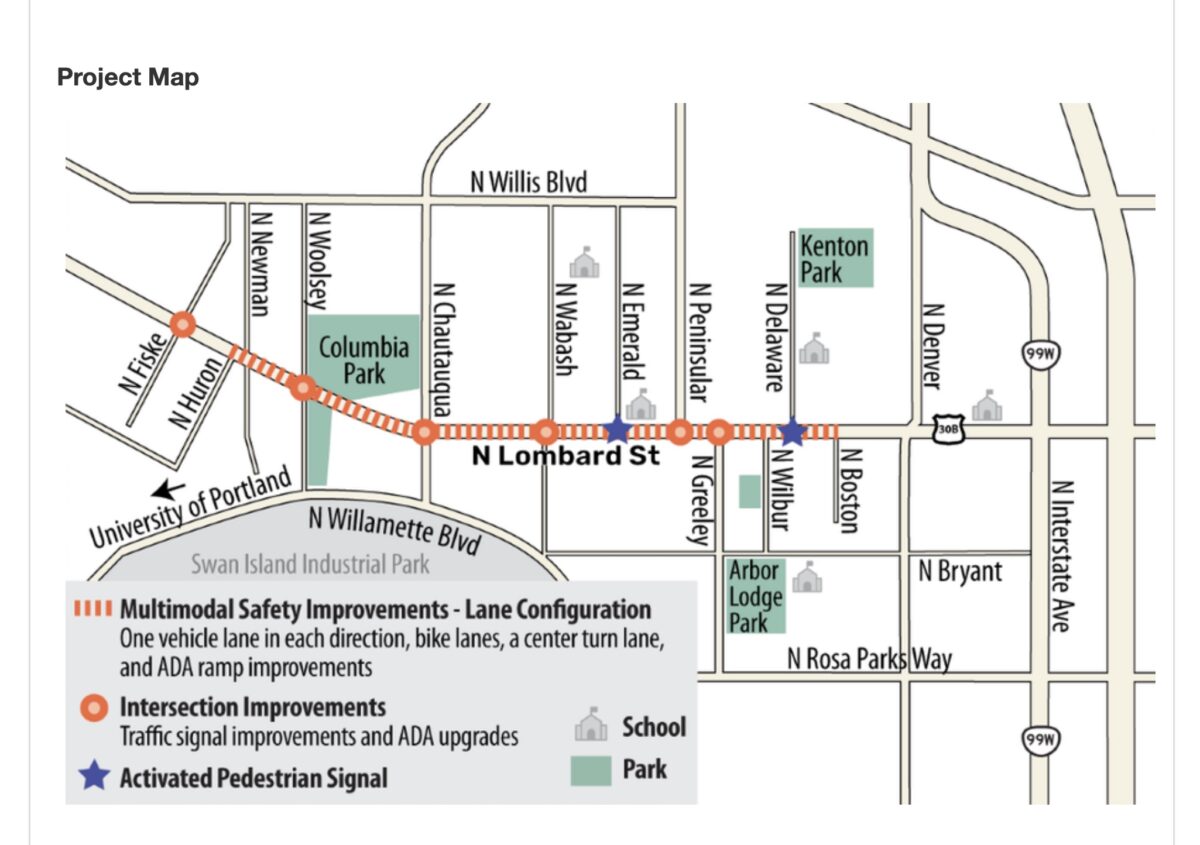


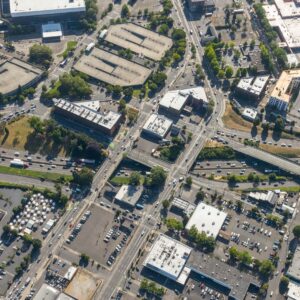
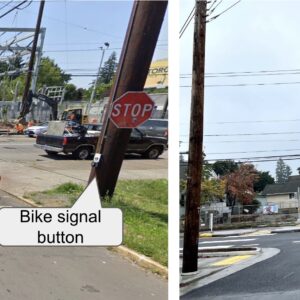
Thanks for reading.
BikePortland has served this community with independent community journalism since 2005. We rely on subscriptions from readers like you to survive. Your financial support is vital in keeping this valuable resource alive and well.
Please subscribe today to strengthen and expand our work.
This section of Lombard is way better, now, but I won’t be biking on it for more than a block or two. To ODOT, this was a road diet + pedestrian crossings project; the bike lanes were entirely incidental. (The failure to go a few more blocks to the N. Denver bike lanes further reinforces the point.)
I told them during a 2019 community meeting that the bike lanes were too small and unprotected and that I wouldn’t expect anyone to use them. They responded that it was either these bike lanes or make a really big shoulder.
This little stretch of Lombard is now far less likely to send Portlanders to the hospital or grave. And the drag racing has stopped. Now onto fixing the rest of this godforsaken road — pushing the improvements to Denver, and pretty please, removing the death traps around Fred Meyer.
Hi Mark in NoPo.
It’s interesting you mention “a block or two”. I think that’s one of the reasons this project is so important. I do gripe a lot about the gaps that remain… But really for folks that come from the immediate neighborhood, having a bike lane for those 1 or 2 blocks that connect to the market or whatever is a big deal! And since it’s not a super safe bike lane in general, just using it sparingly makes sense. thanks for the comment.
OMG This is such a step in the right direction. Keep them coming!
There’s enough greenways and lower traffic streets both north and south of Lombard, so I will prefer to take those when I can. They’re wide enough that people still feel entitled to speed, but at least there are fewer cars and less debris. I do appreciate the increased visibility and closure of some gaps.
I live in this area and I wonder why anyone in their right mind would want to ride a bike on Lombard. It’s a major truck route with heavy traffic and will always be an extremely unpleasant experience. I far prefer to take Willamette or Willis and then cut across to my final destination on Lombard if I need to. And Willamette will always be my preferred route for going further afield (either up to St Johns or starting a trip to downtown or Southeast).
I think the point is similar to the argument recently made for bike lanes on Hawthorne — it’s for that “final destination on Lombard.” You might take other routes to get close by, but once you’re on Lombard, the previous choices (and existing choices in other parts of the road) are with the freight traffic or on the sidewalk.
Just because a bike lane traverses many blocks on a road doesn’t mean anyone expects to ride for many blocks on that road. It can be so that when someone arrives from a side street at any point along that length, they have somewhere to ride to their final destination on the main road.
Expecting bikes to only be on greenways is like expecting cars to only be on freeways: At some point you have to exit and get to where you’re going.
The reduction in noise compared to the old layout is incredible. It’s still a fast, busy road but at least it’s not four lanes of absolute motorized madness anymore.
I agree with Cameron about less busy alternative routes that parallel Lombard and can’t figure out why anyone would want to ride it. I will not be riding it, especially after trying to get to it the it first opened heading wets after turning off of Denver. There are 3-4 blocks of questionable street riding where the lanes merge from 2 to 1 lane and people don’t know quite how to merge or merge at the last moment. I also did not love the mixing of the bike lane and right turn lane at Peninsular.
Heading east from Columbia park was a little nicer but I can’t figure out WTF happened with the intersection at Greeley. That is a very soft corner in front of the UPS Store and for some reason cement was installed instead of asphalt just on that corner, the cement blends in with the sidewalk and the only way drivers can tell that you can drive over it is because the white crosswalk lines are painted over it. Once at that intersection a car was riding parallel to me and did not turn right at the corner but drove past the cement section of the corner and then turned (almost into me). I thought he was going straight as they had to drive halfway into the intersection before making the turn.
Regardless, I will be sticking to Willis, Terry, Bryant, Van Houten and Willamette for my rides in NOPO.
Starbreaker, I totally agree. When they were working on that corner, I thought they were going to extend the sidewalk to tighten the turn and slow drivers down. Then they ended up doing what you described, which of course is so confusing and weird! Another missed opportunity!
Nearly got crushed by a truck right hooking me on the I-5 bit of Rosa Parks the other day. Really quite absurd that there’s no protection there, which also means that it’s hard for me to recomend the route to anyone who’s not experienced or brave.
Big fan of the galleries update, makes looking at the pictures much nicer
Me too Nick! Been a dream of mine to have nice galleries that can be easily scrolled through with captions for so long. I’d still like to have it where we can load a bunch of images together and then just click through each one without having to tile them all on the page. We are always working on the site to make it better.
I saw you out there taking pictures! But I was in my car and couldn’t say hi!
I really wish they’d extend this East of I-5. My ride from work to Fred Meyer on my way home forces me to choose between riding on Columbia, Lombard (where it crosses I-5, yikes!), or a ~6-8 block longer route to use the Bryant St overpass and then backtracking North to Lombard. There are no “safe” ways to cross I-5 between Bryant St and the Columbia Slough Trail.
“The fact that folks no longer have a way to zoom around slower drivers is huge.”
Wish this were true, but now people are using the newly created left turn refuge as a passing lane. I still prefer Willamette or Willis.
These welcome changes have definitely help tame Lombard (somewhat). Walking down the street I’ve noticed a much more neighborhood feel than the freeway vibe it had before. I’m giving it some time before I start riding it to allow motorists to get used to the changes but I’m looking forward to eventually riding it.
Articles that include comments from Region 1 Public Information Officer Don Hamilton should probably have some sort of Trigger Warning at the top. Anything that person says is guaranteed to raise my blood pressure and can be linked to loud exclamations of an obscene nature.
Amen, Mick O.! See my comment further down.
I do like the ribbed lines for the bike lane. I would love for that to be the standard for any unprotected bike lane. Helps alert the distracted drivers when they drift into the lane. Of course it does nothing to stop those who intentionally veer into the lanes. Oh wait, that never happens, right?
This is a million times better and is exactly what we need more of. For anyone who doesn’t agree, I invite you to ride on Lombard from Delaware to MLK which is what we had before.
To bad they didn’t take it to MLK. That would have been really nice as that would make Freddy’s and the I5 crossing much more accessible to a huge number of people.
As to why anyone would ride this, it’s way faster than side streets. I rode Lombard before and will continue to ride the sections without lanes for that reason.
If you want more people cycling, they need to be able to ride from where they actually are to where they’re actually going taking a direct route and carrying some speed so it doesn’t take forever.
In other words, using the thousands of miles of roads in the area rather than a few miles of showcase which you have to get to and from frankly isn’t that great as a riding experience anyway — particularly at night where some becomes so unsafe I’d rather take my chances on the roads with the drunks.
I appreciate the effort, but in my opinion, having planted medians in lieu of bike lanes would have the desired effect of slowing traffic, being pedestrian-friendly, and beautifying a not-so-great area. At least there aren’t all those eye-sore useless plastic popsicle sticks! I struggle using these bike lanes in their current state (width) combined with the volume of traffic (exhaust), businesses (right hooks), cross streets (t-bones), overall danger level… etc. How about a greenway through the university park neighborhood!? Meanwhile, Willamette still sits with no bike lanes to or from St. Johns. I believe the streetcar tracks are still buried under all than new asphalt on Lombard…sigh. The city that paves and paints….and not straight!
They removed a bunch of streetcar tracks during this project, at least around Peninsular Ave.
Don Hamilton blah blah blah. It’s clear he has never ridden a bike thru the Delaware intersection, cuz if he had, he’d know it’s unacceptable – like asking car drivers to get out of their cars, run across a traffic lane, push a button, and run back to the car.
Here’s why agencies like ODOT and PBOT cannot create good cycling infrastructure: Since the creators do not ride bikes, they have no idea what it’ll feel like for cyclists. What if ODOT and PBOT had to hire a certain number of cyclists as a job requirement, instead of looking just at prior experience or academic qualifications?